A Novel Deep-Trench Super-Junction SiC MOSFET with Improved Specific On-Resistance
Abstract
:1. Introduction
2. Device Structure and Work Mechanism
3. Simulation Results and Discussion
4. Proposed Fabrication Process
5. Conclusions
Author Contributions
Funding
Data Availability Statement
Conflicts of Interest
References
- Casady, J.B.; Johnson, R.W. Status of silicon carbide (SiC) as a wide-bandgap semiconductor for high-temperature applications: A review. Solid-State Electron. 1996, 39, 1409–1422. [Google Scholar] [CrossRef]
- Meli, A.; Muoio, A.; Reitano, R.; Sangregorio, E.; Calcagno, L.; Trotta, A.; Parisi, M.; Meda, L.; La Via, F. Effect of the Oxidation Process on Carrier Lifetime and on SF Defects of 4H SiC Thick Epilayer for Detection Applications. Micromachines 2022, 13, 1042. [Google Scholar] [CrossRef] [PubMed]
- Lee, G.; Ha, J.; Kim, K.; Bae, H.; Kim, C.E.; Kim, J. Influence of Radiation-Induced Displacement Defect in 1.2 kV SiC Metal-Oxide-Semiconductor Field-Effect Transistors. Micromachines 2022, 13, 901. [Google Scholar] [CrossRef] [PubMed]
- Liu, S.; Cheng, X.; Zheng, L.; Sledziewski, T.; Yu, Y. Impact of the transition region between active area and edge termination on electrical performance of SiC MOSFET. Solid-State Electron. 2020, 171, 107873. [Google Scholar] [CrossRef]
- Fujihira, T. Theory of Semiconductor Superjunction Devices. Jpn. J. Appl. Phys. 1997, 36, 6254–6262. [Google Scholar] [CrossRef]
- Yu, L.; Sheng, K. Modeling and Optimal Device Design for 4H-SiC Super-Junction Devices. IEEE Trans. Electron Devices 2008, 55, 1961–1969. [Google Scholar] [CrossRef]
- Adachi, K.; Johnson, C.M.; Ohashi, H.; Shinohe, T.; Kinoshita, K.; Arai, K. Comparison of Super-Junction Structures in 4H-SiC and Si for High Voltage Applications. Mater. Sci. Forum 2001, 353–356, 719–722. [Google Scholar] [CrossRef]
- Yu, L.C.; Sheng, K. Breaking the Theoretical Limit of SiC Unipolar Power Device—A Simulation Study. In Proceedings of the International Semiconductor Device Research Symposium, Scottsdale, AZ, USA, 8–11 May 2006. [Google Scholar] [CrossRef]
- Tan, J.; Cooper, J.; Melloch, M.R. High-voltage accumulation-layer UMOSFET’s in 4H-SiC. IEEE Electron Device Lett. 1998, 19, 487–489. [Google Scholar] [CrossRef]
- Nakamura, T.; Nakano, Y.; Aketa, M.; Nakamura, R.; Mitani, S.; Sakairi, H.; Yokotsujiet, Y. High performance SiC trench devices with ultra-low ron. In Proceedings of the 2011 International Electron Devices Meeting, Washington, DC, USA, 5–7 December 2011; IEEE: Piscataway, NJ, USA, 2011; pp. 26.5.1–26.5.3. [Google Scholar]
- Zhou, X.; Yue, R.; Zhang, J.; Dai, G.; Li, J.; Wang, Y. 4H-SiC trench MOSFET with floating/grounded junction barrier-controlled gate structure. IEEE Trans. Electron Devices 2017, 64, 4568–4574. [Google Scholar] [CrossRef]
- Masuda, T.; Saito, Y.; Kumazawa, T.; Hatayama, T.; Harada, S. 0.63 mΩcm2/1170 V 4H-SiC Super Junction V-Groove Trench MOSFET. In Proceedings of the 2018 IEEE International Electron Devices Meeting (IEDM), San Francisco, CA, USA, 1–5 December 2018; IEEE: Piscataway, NJ, USA, 2018; pp. 8.1.1–8.1.4. [Google Scholar]
- Baba, M.; Tawara, T.; Morimoto, T.; Harada, S.; Takei, M.; Kimura, H. Ultra-low specific on-resistance achieved in 3.3 kV-class SiC superjunction MOSFET. In Proceedings of the 2021 33rd International Symposium on Power Semiconductor Devices and ICs (ISPSD), Nagoya, Japan, 30 May–3 June 2021; IEEE: Piscataway, NJ, USA, 2021; pp. 83–86. [Google Scholar]
- Kong, M.; Hu, Z.; Yan, R.; Yi, B.; Zhang, B.; Yang, H. A novel SiC high-k superjunction power MOSFET integrated Schottky barrier diode with improved forward and reverse performance. J. Semicond. 2023, 44, 052801. [Google Scholar] [CrossRef]
- Huang, M.; Deng, Y.; Lai, L.; Yang, Z.; Gao, B.; Gong, M. A vertical superjunction MOSFET with n-Si and p-3C-SiC pillars. IEEE Trans. Electron Devices 2019, 66, 3922–3928. [Google Scholar] [CrossRef]
- Na, J.; Cheon, J.; Kim, K. High performance 4H-SiC MOSFET with deep source trench. Semicond. Sci. Technol. 2022, 37, 045004. [Google Scholar] [CrossRef]
- Hu, S.; Huang, Y.; Liu, T.; Guo, J.; Wang, J.A.; Luo, J. A comparative study of a deep-trench superjunction SiC VDMOS device. J. Comput. Electron. 2019, 18, 553–560. [Google Scholar] [CrossRef]
- Okuto, Y.; Crowell, C.R. Threshold energy effect on avalanche breakdown voltage in semiconductor junctions. Solid State Electron. 1975, 18, 161–168. [Google Scholar] [CrossRef]
- Lombardi, C.; Manzini, S.; Saporito, A.; Vanzi, M. Physically based mobility model for numerical simulation of nonplanar devices. IEEE Trans. Comput. -Aided Des. Integr. Circuits Syst. 1988, 7, 1164–1171. [Google Scholar] [CrossRef]
- Lu, C.-Y.; Cooper, J.; Tsuji, T.; Chung, G.; Williams, J.; McDonald, K.; Feldman, L. Effect of Process Variations and Ambient Temperature on Electron Mobility at the SiO2/4H-SiC Interface. IEEE Trans. Electron Devices 2003, 50, 1582–1588. [Google Scholar] [CrossRef]
- Uchida, K.; Hiyoshi, T.; Nishiguchi, T.; Yamamoto, H.; Matsukawa, S.; Furumai, M.; Mikamura, Y. The Influence of Surface Pit Shape on 4H-SiC MOSFETs Reliability under High Temperature Bias Tests. Mater. Sci. Forum 2016, 858, 840–843. [Google Scholar] [CrossRef]


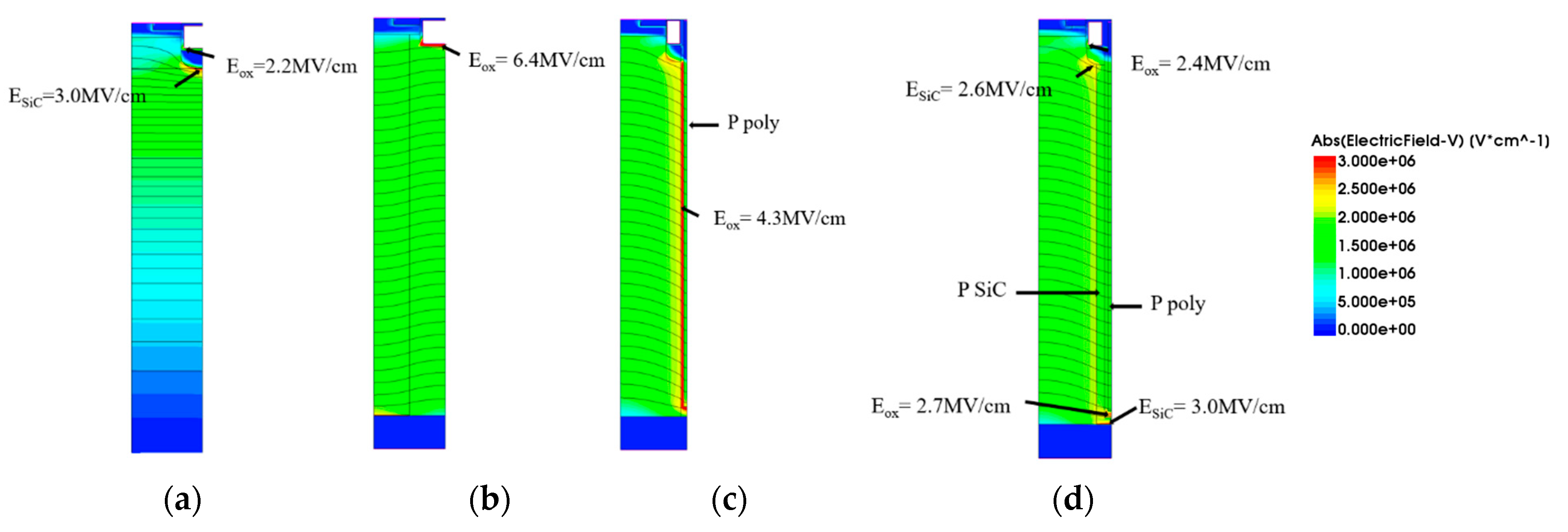

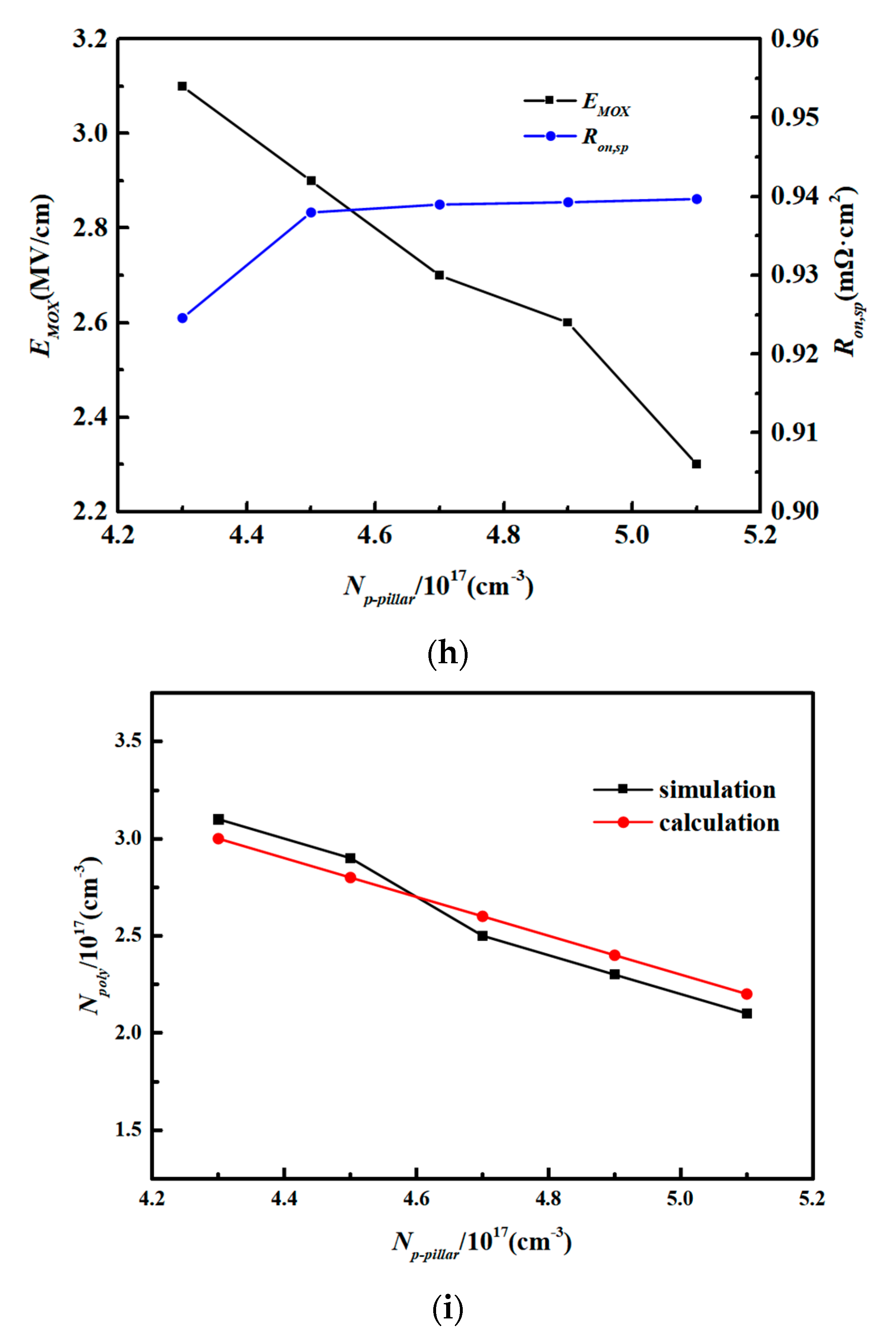
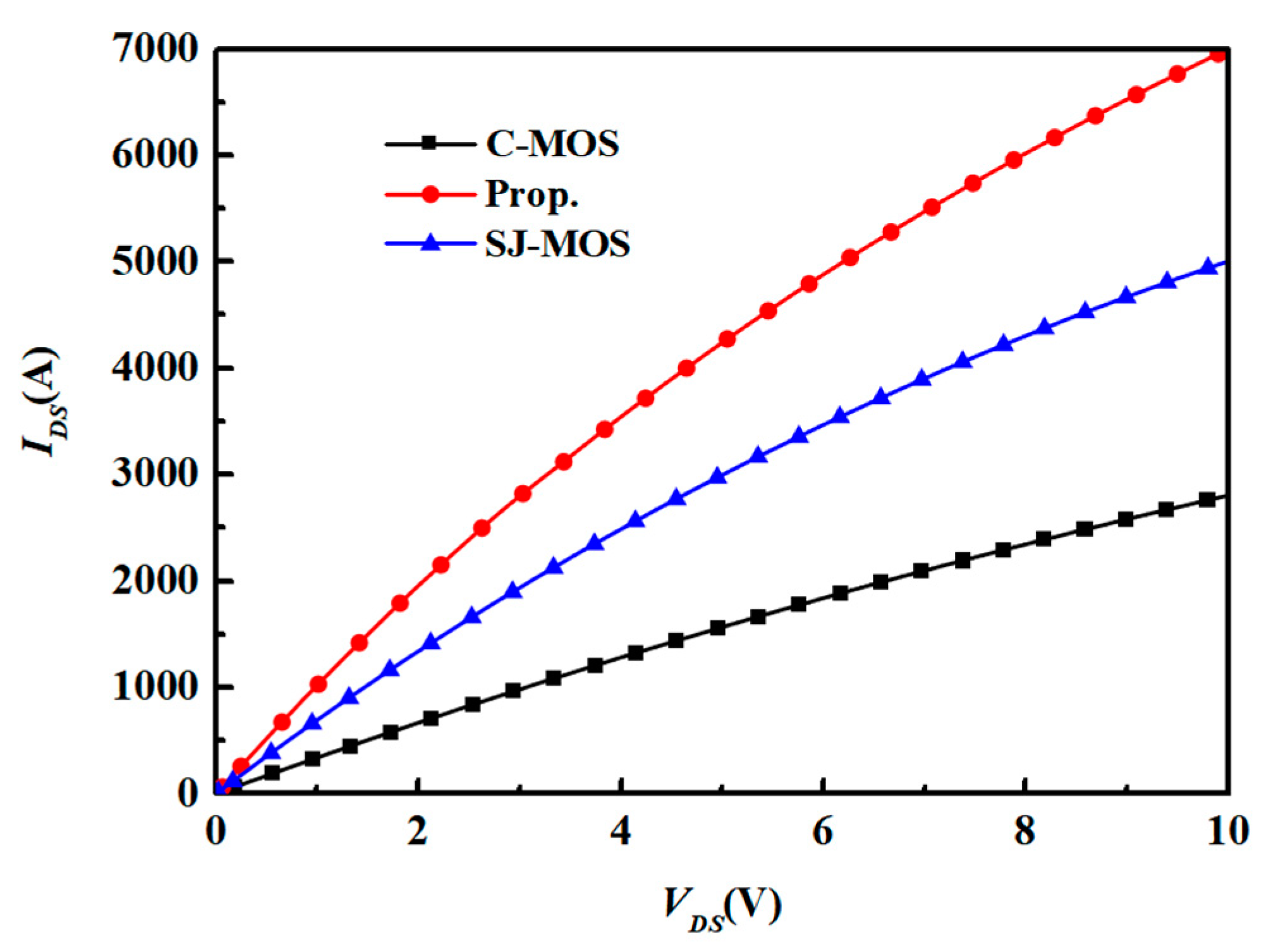


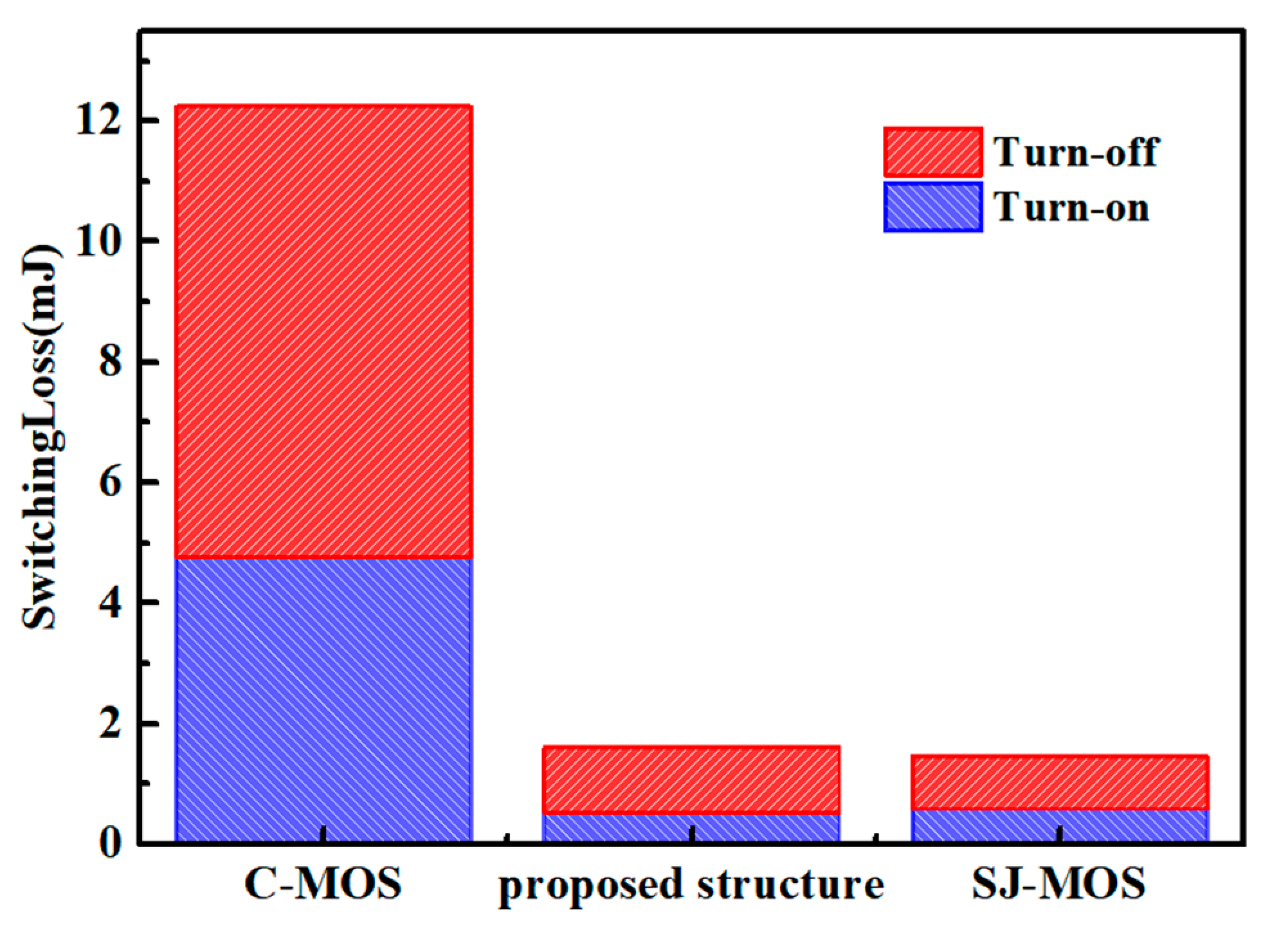

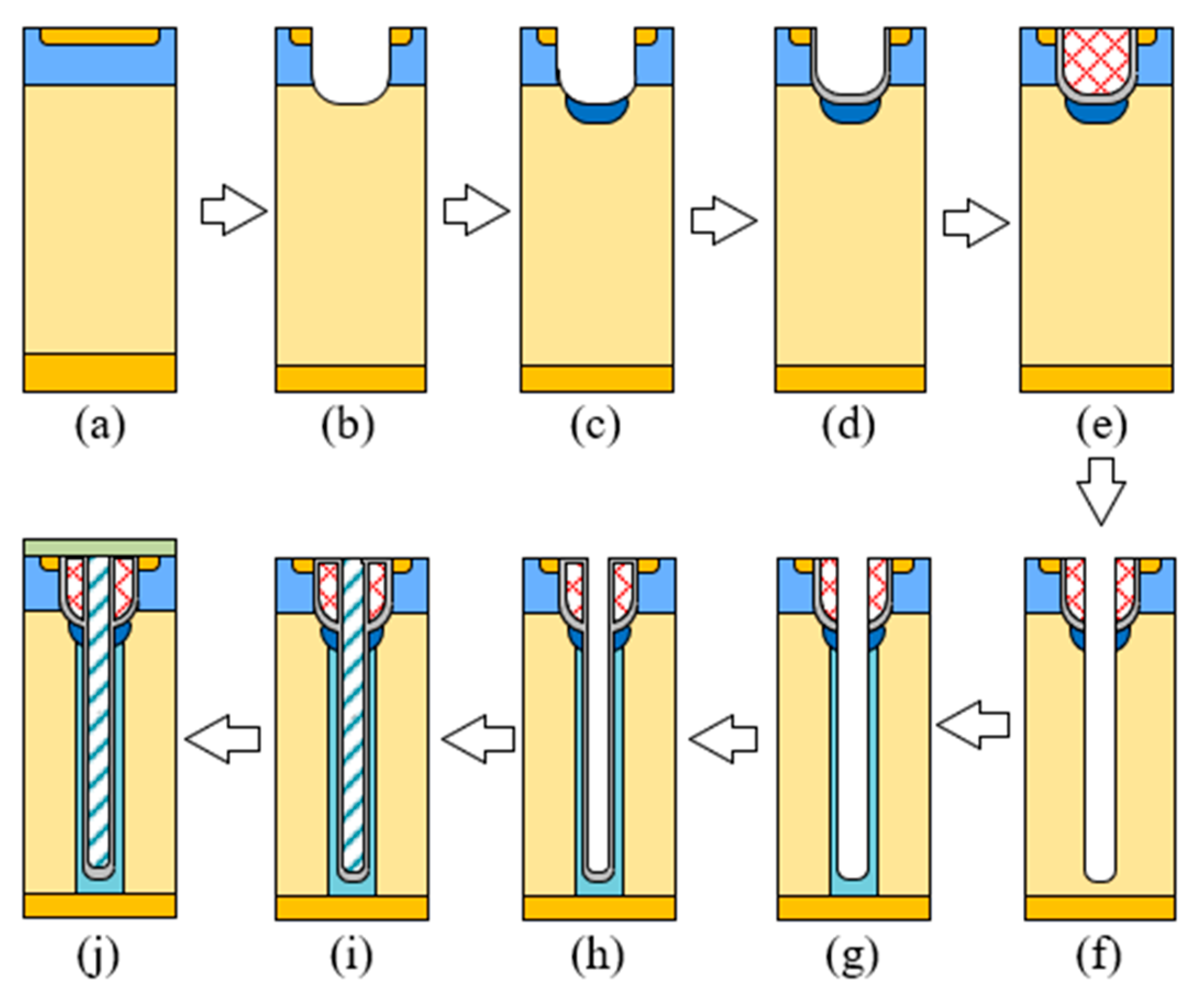
| Parameters | C-MOS | SJ-MOS | DTSJ-MOS | Prop. | Unit |
|---|---|---|---|---|---|
| Cell pitch (full cell) | 2 | 2 | 2 | 2 | μm |
| Depth of gate trench | 0.8 | 0.8 | 0.8 | 0.8 | μm |
| Width of gate trench (full cell) | 0.8 | 0.8 | 0.2 | 0.2 | μm |
| Depth of N drift | 11.5 | 11.5 | 11.5 | 11.5 | μm |
| Width of deep trench (full cell) | / | / | 0.2 | 0.2 | μm |
| Depth of deep trench | / | / | 12 | 11.8 | μm |
| Width of P-pillar (full cell) | / | 1 | / | 0.24 | μm |
| N drift doping | 8 × 1015 | 9.5 × 1016 | 9.5 × 1016 | 9.5 × 1016 | cm−3 |
| P-pillar doping | / | 9.5 × 1016 | / | 4.7 × 1017 | cm−3 |
| P-poly doping | / | / | 8.7 × 1017 | 2.5 × 1017 | cm−3 |
| Thickness of gate trench (side) | 40 | 40 | 40 | 40 | nm |
| Thickness of gate trench (bottom) | 80 | 80 | 80 | 80 | nm |
| Thickness of deep trench (side) | / | / | 50 | 50 | nm |
| Thickness of gate trench (bottom) | / | / | 100 | 100 | nm |
| Parameters | C-MOS | SJ-MOS | Prop. | Unit |
|---|---|---|---|---|
| BV | 1113 | 1809 | 1717 | V |
| Ron,sp | 2.9 | 1.44 | 0.93 | mΩ·cm2 |
| Qgd | 595 | 271 | 101 | nC/cm2 |
| BFOM (BV2/Ron,sp) | 427.2 | 2273 | 3170 | MW/cm2 |
| HF-FOM (Ron,sp × Qgd) | 1725.5 | 390.24 | 93.93 | mΩ·nC |
| Switching Loss | 12.24 | 1.46 | 1.60 | mJ |
| Isat | 1553 | 1395 | 1480 | A |
Disclaimer/Publisher’s Note: The statements, opinions and data contained in all publications are solely those of the individual author(s) and contributor(s) and not of MDPI and/or the editor(s). MDPI and/or the editor(s) disclaim responsibility for any injury to people or property resulting from any ideas, methods, instructions or products referred to in the content. |
© 2024 by the authors. Licensee MDPI, Basel, Switzerland. This article is an open access article distributed under the terms and conditions of the Creative Commons Attribution (CC BY) license (https://creativecommons.org/licenses/by/4.0/).
Share and Cite
Ma, R.; Wang, R.; Fang, H.; Li, P.; Zhao, L.; Wu, H.; Huang, Z.; Tao, J.; Hu, S. A Novel Deep-Trench Super-Junction SiC MOSFET with Improved Specific On-Resistance. Micromachines 2024, 15, 684. https://doi.org/10.3390/mi15060684
Ma R, Wang R, Fang H, Li P, Zhao L, Wu H, Huang Z, Tao J, Hu S. A Novel Deep-Trench Super-Junction SiC MOSFET with Improved Specific On-Resistance. Micromachines. 2024; 15(6):684. https://doi.org/10.3390/mi15060684
Chicago/Turabian StyleMa, Rongyao, Ruoyu Wang, Hao Fang, Ping Li, Longjie Zhao, Hao Wu, Zhiyong Huang, Jingyu Tao, and Shengdong Hu. 2024. "A Novel Deep-Trench Super-Junction SiC MOSFET with Improved Specific On-Resistance" Micromachines 15, no. 6: 684. https://doi.org/10.3390/mi15060684






